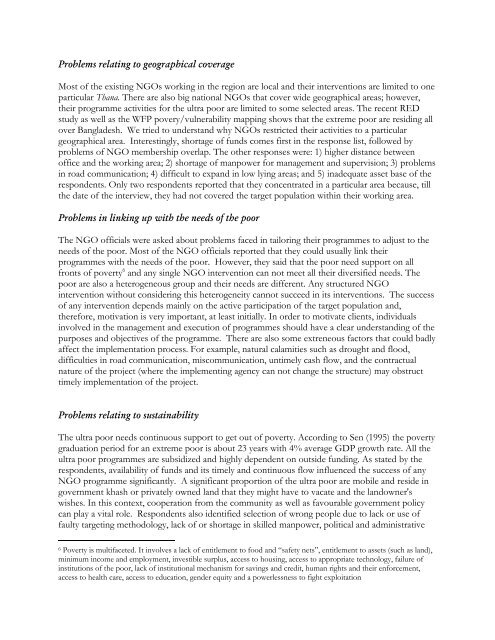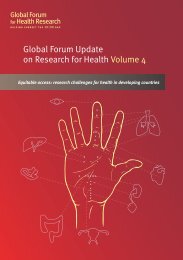Draft for comments only Reviewing existing NGO services for the ...
Draft for comments only Reviewing existing NGO services for the ...
Draft for comments only Reviewing existing NGO services for the ...
You also want an ePaper? Increase the reach of your titles
YUMPU automatically turns print PDFs into web optimized ePapers that Google loves.
Problems relating to geographical coverage<br />
Most of <strong>the</strong> <strong>existing</strong> <strong>NGO</strong>s working in <strong>the</strong> region are local and <strong>the</strong>ir interventions are limited to one<br />
particular Thana. There are also big national <strong>NGO</strong>s that cover wide geographical areas; however,<br />
<strong>the</strong>ir programme activities <strong>for</strong> <strong>the</strong> ultra poor are limited to some selected areas. The recent RED<br />
study as well as <strong>the</strong> WFP povery/vulnerability mapping shows that <strong>the</strong> extreme poor are residing all<br />
over Bangladesh. We tried to understand why <strong>NGO</strong>s restricted <strong>the</strong>ir activities to a particular<br />
geographical area. Interestingly, shortage of funds comes first in <strong>the</strong> response list, followed by<br />
problems of <strong>NGO</strong> membership overlap. The o<strong>the</strong>r responses were: 1) higher distance between<br />
office and <strong>the</strong> working area; 2) shortage of manpower <strong>for</strong> management and supervision; 3) problems<br />
in road communication; 4) difficult to expand in low lying areas; and 5) inadequate asset base of <strong>the</strong><br />
respondents. Only two respondents reported that <strong>the</strong>y concentrated in a particular area because, till<br />
<strong>the</strong> date of <strong>the</strong> interview, <strong>the</strong>y had not covered <strong>the</strong> target population within <strong>the</strong>ir working area.<br />
Problems in linking up with <strong>the</strong> needs of <strong>the</strong> poor<br />
The <strong>NGO</strong> officials were asked about problems faced in tailoring <strong>the</strong>ir programmes to adjust to <strong>the</strong><br />
needs of <strong>the</strong> poor. Most of <strong>the</strong> <strong>NGO</strong> officials reported that <strong>the</strong>y could usually link <strong>the</strong>ir<br />
programmes with <strong>the</strong> needs of <strong>the</strong> poor. However, <strong>the</strong>y said that <strong>the</strong> poor need support on all<br />
fronts of poverty 6 and any single <strong>NGO</strong> intervention can not meet all <strong>the</strong>ir diversified needs. The<br />
poor are also a heterogeneous group and <strong>the</strong>ir needs are different. Any structured <strong>NGO</strong><br />
intervention without considering this heterogeneity cannot succeed in its interventions. The success<br />
of any intervention depends mainly on <strong>the</strong> active participation of <strong>the</strong> target population and,<br />
<strong>the</strong>re<strong>for</strong>e, motivation is very important, at least initially. In order to motivate clients, individuals<br />
involved in <strong>the</strong> management and execution of programmes should have a clear understanding of <strong>the</strong><br />
purposes and objectives of <strong>the</strong> programme. There are also some extreneous factors that could badly<br />
affect <strong>the</strong> implementation process. For example, natural calamities such as drought and flood,<br />
difficulties in road communication, miscommunication, untimely cash flow, and <strong>the</strong> contractual<br />
nature of <strong>the</strong> project (where <strong>the</strong> implementing agency can not change <strong>the</strong> structure) may obstruct<br />
timely implementation of <strong>the</strong> project.<br />
Problems relating to sustainability<br />
The ultra poor needs continuous support to get out of poverty. According to Sen (1995) <strong>the</strong> poverty<br />
graduation period <strong>for</strong> an extreme poor is about 23 years with 4% average GDP growth rate. All <strong>the</strong><br />
ultra poor programmes are subsidized and highly dependent on outside funding. As stated by <strong>the</strong><br />
respondents, availability of funds and its timely and continuous flow influenced <strong>the</strong> success of any<br />
<strong>NGO</strong> programme significantly. A significant proportion of <strong>the</strong> ultra poor are mobile and reside in<br />
government khash or privately owned land that <strong>the</strong>y might have to vacate and <strong>the</strong> landowner's<br />
wishes. In this context, cooperation from <strong>the</strong> community as well as favourable government policy<br />
can play a vital role. Respondents also identified selection of wrong people due to lack or use of<br />
faulty targeting methodology, lack of or shortage in skilled manpower, political and administrative<br />
6 Poverty is multifaceted. It involves a lack of entitlement to food and “safety nets”, entitlement to assets (such as land),<br />
minimum income and employment, investible surplus, access to housing, access to appropriate technology, failure of<br />
institutions of <strong>the</strong> poor, lack of institutional mechanism <strong>for</strong> savings and credit, human rights and <strong>the</strong>ir en<strong>for</strong>cement,<br />
access to health care, access to education, gender equity and a powerlessness to fight exploitation
















![[re-tender] RFQ for supply of Diesel Generator - Brac](https://img.yumpu.com/44421374/1/186x260/re-tender-rfq-for-supply-of-diesel-generator-brac.jpg?quality=85)
